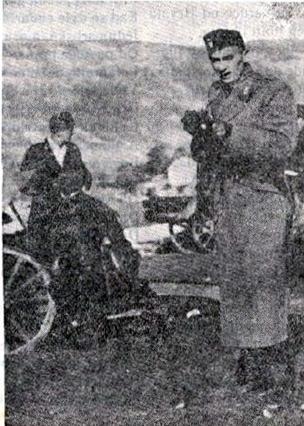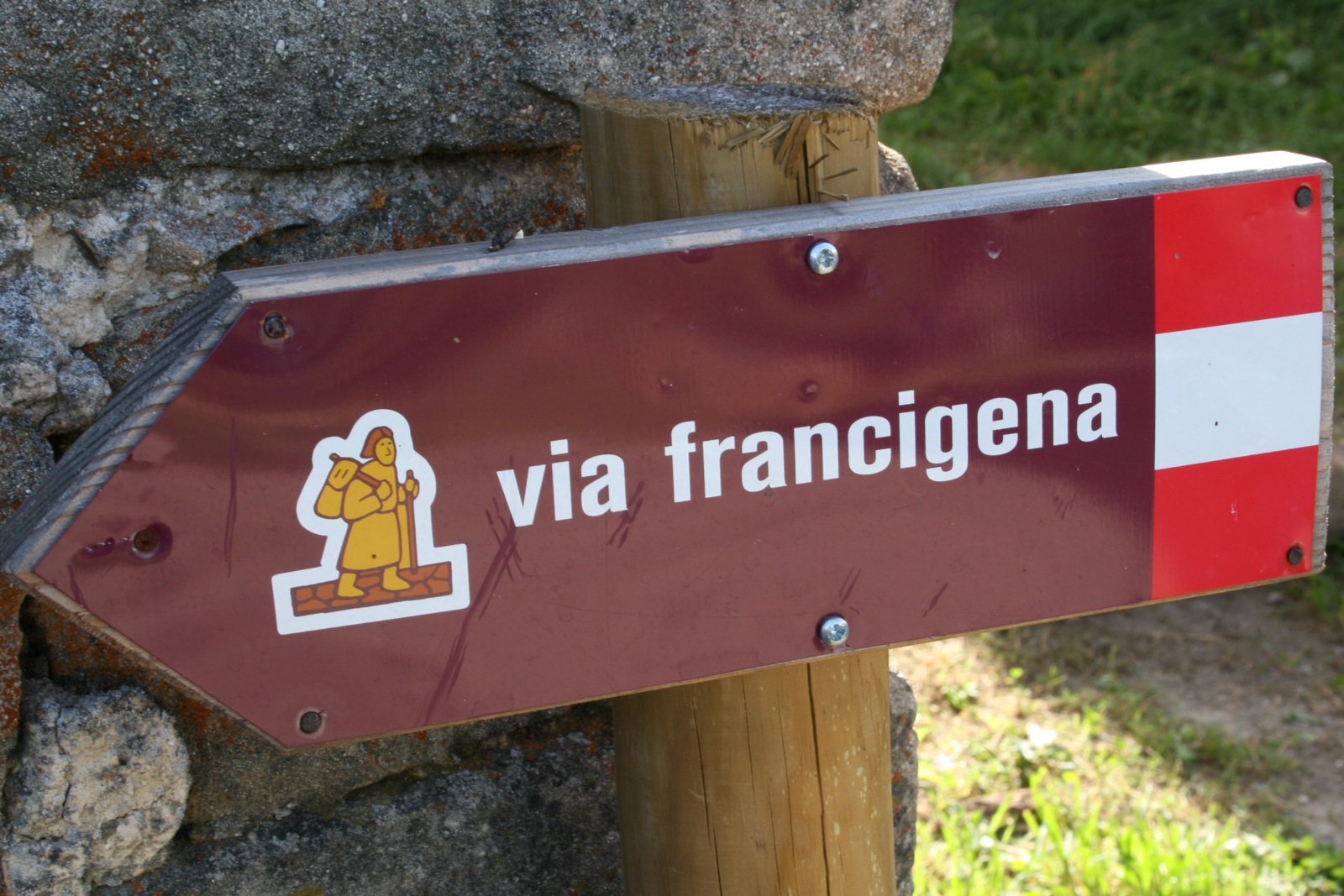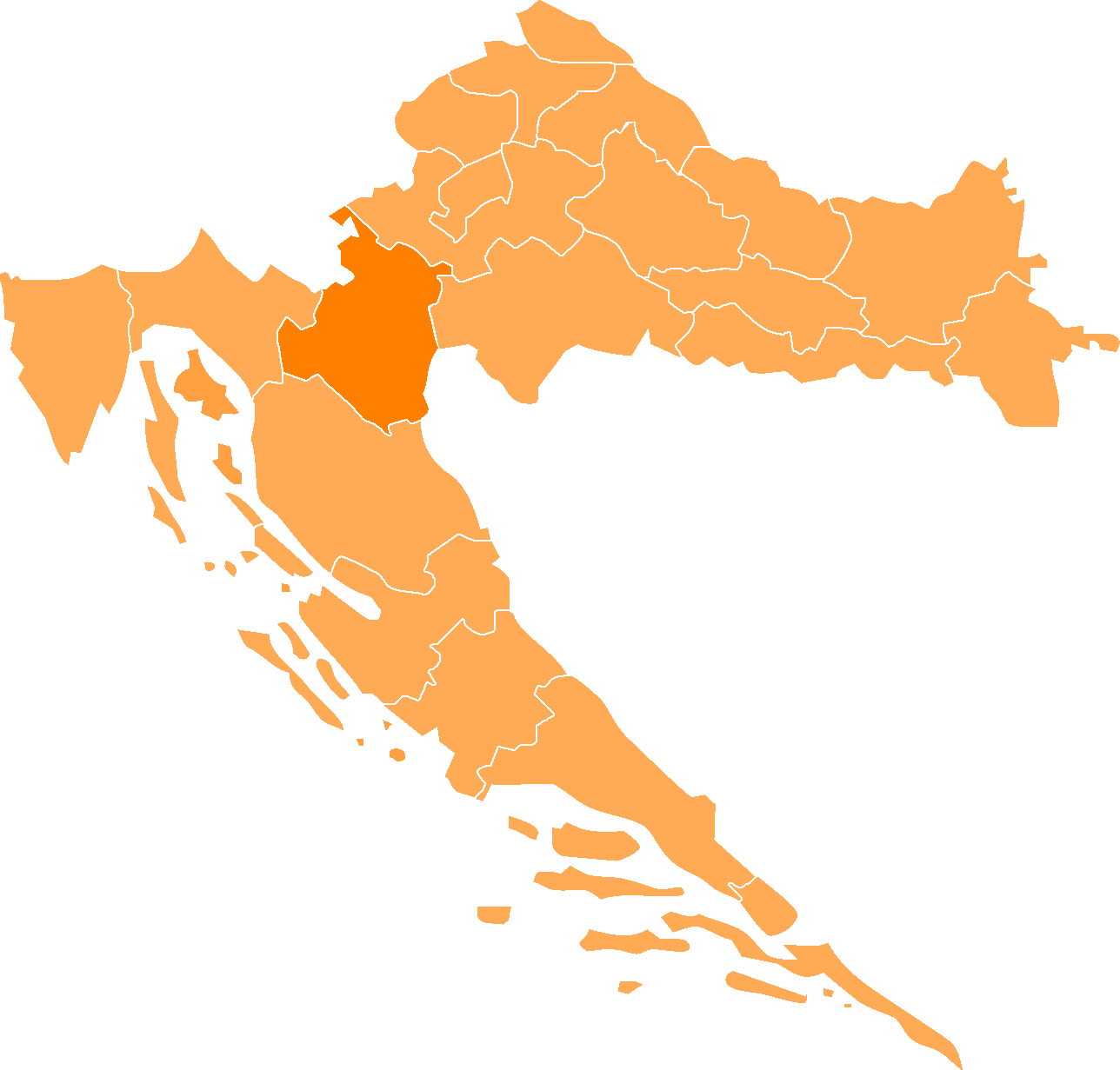|
Jure Francetić
Jure Francetić (3 July 1912 – 27/28 December 1942) was a Croatian Ustaša Commissioner for the Bosnia and Herzegovina regions of the Independent State of Croatia (NDH) during World War II, and commander of the 1st Ustaše Regiment of the Ustaše Militia, later known as the Black Legion. In both roles he was responsible for the massacre of Bosnian Serbs and Jews. A member of Ante Pavelić's inner circle, he was considered by many Ustaše as a possible successor to Pavelić as Poglavnik (leader) of the NDH. He died of wounds inflicted when he was captured by Partisans near Slunj in the Kordun region when his aircraft crash-landed there in late December 1942. Early life prior to formation of NDH Francetić was born in Otočac in the mountainous Lika region of modern-day central Croatia on 3 July 1912. After high school where he was influenced by nationalist teachers, he went to study law at the University of Zagreb, where he joined the Ustaša movement and abandoned his s ... [...More Info...] [...Related Items...] OR: [Wikipedia] [Google] [Baidu] |
Otočac
Otočac () is a town in Croatia, former bishopric and present Latin Catholic titular see. It lies in the northwestern part of Lika region, in the Gacka river valley. The population of the administrative area of the Town of Otočac was 9,778 in 2011, with 4,240 in Otočac itself, the majority of whom were Croats (91%). Name The town is known as ''Otocsán'' in Hungarian language, Hungarian, ''Ottocio'' in Italian language, Italian, and ''Ottocium'' in Latin. In historical sources, the name has been rendered as ''Ottochaz'' (German and English language, English), ''Ottocaz'' (Italian and German), and ''Ottotschaz'', ''Ottotschan'', & ''Ottocsaz'' (German language, German). History Otočac was named after the early Croatian parish. The text of the famous Baška Tablet (around 1100) says that the church of St. Nicholas in Otočac was part of the Holy Orders, order community with the Church of St. Lucy, Jurandvor on the island of Krk. From 1300 on, it belonged to the estate of the Fr ... [...More Info...] [...Related Items...] OR: [Wikipedia] [Google] [Baidu] |
Herzegovina
Herzegovina ( or ; sh-Latn-Cyrl, Hercegovina, separator=" / ", Херцеговина, ) is the southern and smaller of two main geographical region of Bosnia and Herzegovina, the other being Bosnia. It has never had strictly defined geographical or cultural-historical borders, nor has it ever been defined as an administrative whole in the geopolitical and economic subdivision of Bosnia and Herzegovina. Bosnia, the larger of the two regions, lies to the north of Herzegovina; the Croatian region of Dalmatia lies to the southwest; the Montenegrin region of Old Herzegovina lies to the southeast. The land area of Herzegovina is around , or around 23–24% of the country. The largest city is Mostar, in the center of the region. Other large settlements include Trebinje, Široki Brijeg, Ljubuški, Čapljina, Konjic and Posušje. Etymology The name (or ''Herzegovina'' in English) stems from German (the German term for a duke; sh, vojvoda), and means a land ruled and/or owned ... [...More Info...] [...Related Items...] OR: [Wikipedia] [Google] [Baidu] |
Borgo Val Di Taro
Borgo Val di Taro, usually referred to as Borgotaro, (Parmigiano: ; locally ) is a town and ''comune'' in Emilia, Italy, in the Province of Parma, from the city of Parma. Borgo Val di Taro is an important centre for cattle husbandry in Emilia and it is one of the zones where Parmigiano-Reggiano is produced. The area is well known for its ''Boletus edulis'' (porcini) mushrooms, and several boletes that grow there have IGP (English: PGI) status. James Gandolfini Sr., father of Italian-American actor James Gandolfini Jr., was born in Borgo Val di Taro. Main sights Not far from the town is the small church of S. Antonio del Viennese, a 13th-century structure in brick. The city hall (''palazzo comunale''), in the Lombard Gothic style, is a work of the 14th century. Tourism and gastronomic tours are important factors of the modern economy. The town is a member of the Cittaslow (slow city) movement. Frazioni Banca, Barca, Barzana di Sotto, Baselica, Belforte, Bissaio, Boceto, Boz ... [...More Info...] [...Related Items...] OR: [Wikipedia] [Google] [Baidu] |
Italy
Italy ( it, Italia ), officially the Italian Republic, ) or the Republic of Italy, is a country in Southern Europe. It is located in the middle of the Mediterranean Sea, and its territory largely coincides with the homonymous geographical region. Italy is also considered part of Western Europe, and shares land borders with France, Switzerland, Austria, Slovenia and the enclaved microstates of Vatican City and San Marino. It has a territorial exclave in Switzerland, Campione. Italy covers an area of , with a population of over 60 million. It is the third-most populous member state of the European Union, the sixth-most populous country in Europe, and the tenth-largest country in the continent by land area. Italy's capital and largest city is Rome. Italy was the native place of many civilizations such as the Italic peoples and the Etruscans, while due to its central geographic location in Southern Europe and the Mediterranean, the country has also historically been home ... [...More Info...] [...Related Items...] OR: [Wikipedia] [Google] [Baidu] |
University Of Zagreb
The University of Zagreb ( hr, Sveučilište u Zagrebu, ; la, Universitas Studiorum Zagrabiensis) is the largest Croatian university and the oldest continuously operating university in the area covering Central Europe south of Vienna and all of Southeastern Europe. The University of Zagreb and the University North are the only public universities operating in Northern and Central Croatia. The history of the University began on September 23, 1669, when the Holy Roman Emperor Leopold I issued a decree granting the establishment of the ''Jesuit Academy of the Royal Free City of Zagreb''. The decree was accepted at the Council of the Croatian Kingdom on November 3, 1671. The Academy was run by the Jesuits for more than a century until the order was dissolved by Pope Clement XIV in 1773. In 1776, Empress Maria Theresa issued a decree founding the ''Royal Academy of Science'' which succeeded the previous Jesuit Academy. Bishop Josip Juraj Strossmayer proposed the founding of a Univ ... [...More Info...] [...Related Items...] OR: [Wikipedia] [Google] [Baidu] |
Croatia
, image_flag = Flag of Croatia.svg , image_coat = Coat of arms of Croatia.svg , anthem = "Lijepa naša domovino"("Our Beautiful Homeland") , image_map = , map_caption = , capital = Zagreb , coordinates = , largest_city = capital , official_languages = Croatian , languages_type = Writing system , languages = Latin , ethnic_groups = , ethnic_groups_year = 2021 , religion = , religion_year = 2021 , demonym = , government_type = Unitary parliamentary republic , leader_title1 = President , leader_name1 = Zoran Milanović , leader_title2 = Prime Minister , leader_name2 = Andrej Plenković , leader_title3 = Speaker of Parliament , leader_name3 = Gordan Jandroković , legislature = Sabor , sovereignty_type ... [...More Info...] [...Related Items...] OR: [Wikipedia] [Google] [Baidu] |
Lika
Lika () is a traditional region of Croatia proper, roughly bound by the Velebit mountain from the southwest and the Plješevica mountain from the northeast. On the north-west end Lika is bounded by Ogulin-Plaški basin, and on the south-east by the Malovan pass. Today most of the territory of Lika ( Brinje, Donji Lapac, Gospić, Lovinac, Otočac, Perušić, Plitvička Jezera, Udbina and Vrhovine) is part of Lika-Senj County. Josipdol, Plaški and Saborsko are part of Karlovac County and Gračac is part of Zadar County. Major towns include Gospić, Otočac, and Gračac, most of which are located in the karst poljes of the rivers of Lika, Gacka and others. The Plitvice Lakes National Park is also in Lika. History Antiquity Since the first millennium BC the region was inhabited by Iapydes, an ancient people related to Illyrians. During the Gallic invasion of the Balkans, a division of the Gallic army passed through the territory of today's Lika and a part of this army sett ... [...More Info...] [...Related Items...] OR: [Wikipedia] [Google] [Baidu] |
Kordun
The Kordun () region is a part of central Croatia from the bottom of the Petrova Gora (Peter's mountain) mountain range, which extends along the rivers Korana and Slunjčica, and forms part of the border region to Bosnia and Herzegovina. Within Croatia, Kordun is bordered by the Lika region to the south and by Banovina or Banija to the east. Most of Kordun with its centre Slunj belongs to Karlovac County (Slunj, Cetingrad, Krnjak, Rakovica and Vojnić). Vrginmost belongs to Sisak-Moslavina County. In former times, this region belonged to the Habsburg Military Frontier towards the Ottoman Empire. Following the Croatian War of Independence, a number of towns and municipalities in the region were designated Areas of Special State Concern. The area has rich wood resources. Today, the economic situation is slowly improving, but there is still a large tendency of emigration from the region to larger cities. A typical phenomenon of this region is the porous composition of the karst ... [...More Info...] [...Related Items...] OR: [Wikipedia] [Google] [Baidu] |
Yugoslav Partisans
The Yugoslav Partisans,Serbo-Croatian, Macedonian, Slovene: , or the National Liberation Army, sh-Latn-Cyrl, Narodnooslobodilačka vojska (NOV), Народноослободилачка војска (НОВ); mk, Народноослободителна војска (НОВ); sl, Narodnoosvobodilna vojska (NOV) officially the National Liberation Army and Partisan Detachments of Yugoslavia, sh-Latn-Cyrl, Narodnooslobodilačka vojska i partizanski odredi Jugoslavije (NOV i POJ), Народноослободилачка војска и партизански одреди Југославије (НОВ и ПОЈ); mk, Народноослободителна војска и партизански одреди на Југославија (НОВ и ПОЈ); sl, Narodnoosvobodilna vojska in partizanski odredi Jugoslavije (NOV in POJ) was the communist-led anti-fascist resistance to the Axis powers (chiefly Germany) in occupied Yugoslavia during World War II. Led by Josip Broz T ... [...More Info...] [...Related Items...] OR: [Wikipedia] [Google] [Baidu] |
Poglavnik
() was the title used by Ante Pavelić, leader of the World War II Croatian movement Ustaše and of the Independent State of Croatia between 1941 and 1945. Etymology and usage The word was first recorded in a 16th-century dictionary compiled by Fausto Veranziohttp://www.hrcak.srce.hr/file/95656 as a Croatian term for the Latin word princeps. According to Vladimir Anić's ''Rječnik hrvatskoga jezika'' (Croatian Dictionary) and the '' Croatian Encyclopedic Dictionary'' the word comes from the adjective form ''poglavit'', which can be loosely translated as 'first and foremost' or 'respectable, noble, honorable'. The adjective is in turn a compound of the Croatian prefix ''po-'' and the Proto-Slavic word stem ''glava'' 'head'. Because it was used by the fascist regime, the title (which had originally meant "head" or "chief" but was rarely used before the 1930s) is never used today in its original sense as it became synonymous with Pavelić and took on negative connotations aft ... [...More Info...] [...Related Items...] OR: [Wikipedia] [Google] [Baidu] |
Ante Pavelić
Ante Pavelić (; 14 July 1889 – 28 December 1959) was a Croatian politician who founded and headed the fascist ultranationalist organization known as the Ustaše in 1929 and served as dictator of the Independent State of Croatia ( hr, links=no, Nezavisna Država Hrvatska, NDH), a fascist puppet state built out of parts of occupied Yugoslavia by the authorities of Nazi Germany and Fascist Italy, from 1941 to 1945. Pavelić and the Ustaše persecuted many racial minorities and political opponents in the NDH during the war, including Serbs, Jews, Romani, and anti-fascists, becoming one of the key figures of the genocide of Serbs, the Porajmos and the Holocaust in the NDH. At the start of his career, Pavelić was a lawyer and a politician of the Croatian Party of Rights in the Kingdom of Yugoslavia known for his nationalist beliefs and support for an independent Croatia. By the end of the 1920s, his political activity became more radical as he called on Croats to revolt ... [...More Info...] [...Related Items...] OR: [Wikipedia] [Google] [Baidu] |
Bosnian Jews
The history of Jews in Bosnia and Herzegovina spans from the arrival of the first Bosnian Jews as a result of the Spanish Inquisition to the survival of the Bosnian Jews through the Holocaust and the Yugoslav Wars. Judaism and the Jewish community in Bosnia and Herzegovina has one of the oldest and most diverse histories in the former Yugoslav states, and is more than 500 years old, in terms of permanent settlement. Then a self-governing province of the Ottoman Empire, Bosnia was one of the few territories in Europe that welcomed Jews after their expulsion from Spain. At its peak, the Jewish community of Bosnia and Herzegovina numbered between 14,000 and 22,000 members in 1941. Of those, 12,000 to 14,000 lived in Sarajevo, comprising 20% of the city's population. Today, there are 281 Jews living in Bosnia and Herzegovina, recognised as a national minority. They mostly have good relations with their non-Jewish neighbors. History Ottoman rule The first Jews arrived to ... [...More Info...] [...Related Items...] OR: [Wikipedia] [Google] [Baidu] |



.jpg)





